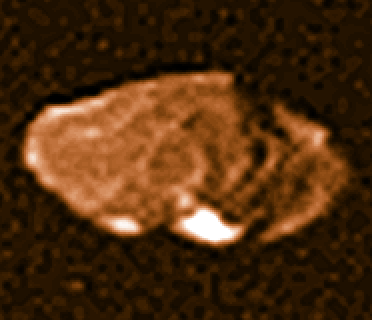Amalthea

Amalthea imaged by Voyager 1. Credit: NASA.
Amalthea is an inner moon of Jupiter. It is the largest of Jupiter's non-Galilean satellites and one of four moons that circle around Jupiter inside the orbit of Io. Amalthea is potato-shaped like the martian moon Phobos but 10 times bigger. Two large craters stand out on its heavily-cratered surface: Pan, 90 kilometers in diameter and 8 km deep, and Gaea, 75 kilometers in diameter and 16 kilometers deep. Two mountains have been identified: Mons Ida and Mons Lyctos. Amalthea is dark and the reddest object known in the Solar System. Its coloration is probably due to sulfur from Io's volcanoes which has spiraled down toward Jupiter and impacted on Amalthea's surface. Bright green patches on the moon's major slopes are of unknown origin. Amalthea is also unusual in that it appears to give out more heat than it receives from the Sun. Tidal stresses could be one possible source of this heat; alternatively, it may arise from electrical currents induced in the moon's core by Jupiter's powerful magnetic field. Material lost from the surface of Amalthea, and also from Thebe, appears to comprise Jupiter's Gossamer Ring.
Observations of Amalthea by the Galileo spacecraft, in late 2002, showed that the moon has a very low density, indicating that it may be a loosely packed pile of rubble. The gaps between solid chunks likely take up more of the moon's total volume than the solid pieces, and even the chunks are probably material that is not dense enough to fit some theories about the origin of Jupiter's moons. Amalthea now seems more likely to be mostly rock with perhaps a little ice, rather than a denser mix of rock and iron. Its irregular shape and low density suggest it has been broken into many pieces that cling together from the pull of each other's gravity, mixed with empty spaces where the pieces don't fit tightly together. Galileo's discovery supports the idea that the inner moons of Jupiter have undergone intense bombardment and breakup. Amalthea does not have quite enough mass to pull itself together into a consolidated, spherical body like Earth's Moon or Jupiter's four largest moons. The density estimate, obtained from Galileo's flyby, extends an emerging pattern of finding irregularly shaped moons and asteroids to be porous rubble piles. What's more of a surprise is the density estimate is so low that even the solid parts of Amalthea are apparently less dense than Io. One model for the formation of Jupiter's moons suggests moons closer to the planet would be made of denser material than those farther out. This is based on a theory that the infant Jupiter, like a weaker version of the early Sun, would have emitted enough heat to prevent volatile, low-density material from condensing and being incorporated into the closer moons. Jupiter's four largest moons fit this model, with the innermost of them, Io, also the densest, made mainly of rock and iron. See also rubble-pile asteroid.
| discovery | Sep 9, 1892, by Edward E. Barnard |
| semimajor axis | 181,170 km (112,600 mi) |
| diameter | 262 × 146 × 134 km (163 × 91 × 83 mi) |
| mean density | 0.86 g/cm3 |
| escape velocity | 0.061 km/s (220 km/h, 137 mph) |
| orbital period | 0.498 day (11 h 57 min) |
| orbital eccentricity | 0.005 |
| orbital inclination | 0.36° |
| axial period | synchronous |
| visual albedo | 0.09 |


